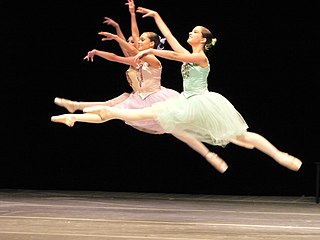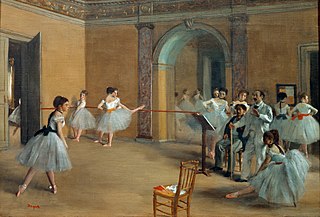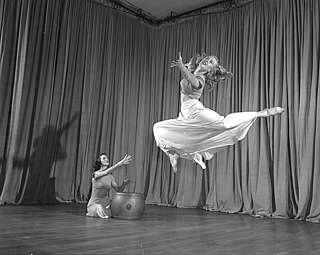
Ballet is a type of performance dance that originated during the Italian Renaissance in the fifteenth century and later developed into a concert dance form in France and Russia. It has since become a widespread and highly technical form of dance with its own vocabulary. Ballet has been influential globally and has defined the foundational techniques which are used in many other dance genres and cultures. Various schools around the world have incorporated their own cultures. As a result, ballet has evolved in distinct ways.

Choreography is the art or practice of designing sequences of movements of physical bodies in which motion or form or both are specified. Choreography may also refer to the design itself. A choreographer is one who creates choreographies by practising the art of choreography, a process known as choreographing. It most commonly refers to dance choreography.

The history of dance is difficult to access because dance does not often leave behind clearly identifiable physical artifacts that last over millennia, such as stone tools, hunting implements or cave paintings. It is not possible to identify with exact precision when dance becomes part of human culture. Dance is filled with aesthetic values, making it distinct from one society to another and is shrouded in symbolism that expounds on the cultural heritage of a community accordingly being unique from one society to another. Dance can help tell a story, convey feelings and emotions, and connect with others and ourselves.
Dance improvisation is the process of spontaneously creating movement. Development of movement material is facilitated through a variety of creative explorations including body mapping through levels, shape and dynamics schema.

Contemporary dance is a genre of dance performance that developed during the mid-twentieth century and has since grown to become one of the dominant genres for formally trained dancers throughout the world, with particularly strong popularity in the U.S. and Europe. Although originally informed by and borrowing from classical, modern, and jazz styles, it has come to incorporate elements from many styles of dance. According to the New Grove Musical Dictionary, contemporary dance evolved from the foundations of modern and postmodern dance, emphasizing innovation and a break from traditional forms. Due to its technical similarities, it is often perceived to be closely related to modern dance, ballet, and other classical concert dance styles. It is characterized by a blend of styles that often integrate elements of ballet, modern dance, and cultural or social dance forms.
This is an alphabetical index of articles related to dance.

Concert dance is dance performed for an audience. It is frequently performed in a theatre setting, though this is not a requirement, and it is usually choreographed and performed to set music.
Postmodern dance is a 20th century concert dance movement that came into popularity in the early 1960s. While the term postmodern took on a different meaning when used to describe dance, the dance form did take inspiration from the ideologies of the wider postmodern movement, which "sought to deflate what it saw as overly pretentious and ultimately self-serving modernist views of art and the artist" and was, more generally, a departure from modernist ideals. Lacking stylistic homogeny, postmodern dance was discerned mainly by its anti-modern dance sentiments rather than by its dance style. The dance form was a reaction to the compositional and presentational constraints of the preceding generation of modern dance, hailing the use of everyday movement as valid performance art and advocating for unconventional methods of dance composition.
The United States of America is the home of the hip hop dance, swing, tap dance and its derivative Rock and Roll, and modern square dance and one of the major centers for modern dance. There is a variety of social dance and performance or concert dance forms with also a range of traditions of Native American dances.

Classical ballet is any of the traditional, formal styles of ballet that exclusively employ classical ballet technique. It is known for its aesthetics and rigorous technique, its flowing, precise movements, and its ethereal qualities.

Hip hop dance is a range of street dance styles primarily performed to hip hop music or that have evolved as part of hip hop culture. It is influenced by a wide range of styles that were created in the 1970s and made popular by dance crews in the United States. The television show Soul Train and the 1980s films Breakin', Beat Street, and Wild Style showcased these crews and dance styles in their early stages; therefore, giving hip-hop dance mainstream exposure.

Breakdancing or breaking, also called b-boying or b-girling (women), is a style of street dance originated by African Americans and Nuyoricans in the Bronx.

Contemporary ballet is a genre of dance that incorporates elements of classical ballet and modern dance. It employs classical ballet technique and in many cases classical pointe technique as well, but allows a greater range of movement of the upper body and is not constrained to the rigorously defined body lines and forms found in traditional, classical ballet. Many of its attributes come from the ideas and innovations of 20th-century modern dance, including floor work and turn-in of the legs. The style also contains many movements emphasizing the body's flexibility.

Interpretive dance is a family of modern dance styles that began around 1900 with Isadora Duncan. It used classical concert music but marked a departure from traditional concert dance, as a rebellion against the strict rules of classical ballet. It seeks to translate human emotions, conditions, situations or fantasies into movement and dramatic expression, as opposed to following a specific dance style or telling a linear story. It may also adapt traditional ethnic movements into more modern expressions.

African-American dance is a form of dance that was created by Africans in the Diaspora, specifically the United States. It has developed within various spaces throughout African-American communities in the United States, rather than studios, schools, or companies. These dances are usually centered on folk and social dance practice, though performance dance often supplies complementary aspects to this. Placing great value on improvisation, these dances are characterized by ongoing change and development. There are a number of notable African-American modern dance companies using African-American cultural dance as an inspiration, among these are the Whitey's Lindy Hoppers, Alvin Ailey American Dance Theater, Dance Theatre of Harlem, and Katherine Dunham Company. Hollywood and Broadway have also provided opportunities for African-American artists to share their work and for the public to support them.

Modern dance is a broad genre of western concert or theatrical dance which includes dance styles such as ballet, folk, ethnic, religious, and social dancing; and primarily arose out of Europe and the United States in the late 19th and early 20th centuries. It was considered to have been developed as a rejection of, or rebellion against, classical ballet, and also a way to express social concerns like socioeconomic and cultural factors.

Somatics is a field within bodywork and movement studies which emphasizes internal physical perception and experience. The term is used in movement therapy to signify approaches based on the soma, or "the body as perceived from within", including Skinner Releasing Technique, Alexander technique, the Feldenkrais Method, Eutony, Rolfing Structural Integration, among others. In dance, the term refers to techniques based on the dancer's internal sensation, in contrast with "performative techniques", such as ballet or modern dance, which emphasize the external observation of movement by an audience. Somatic techniques may be used in bodywork, psychotherapy, dance, or spiritual practices.

Graham technique is a modern dance movement style and pedagogy created by American dancer and choreographer Martha Graham (1894–1991). Graham technique has been called the "cornerstone" of American modern dance, and has been taught worldwide. It is widely regarded as the first codified modern dance technique, and strongly influenced the later techniques of Merce Cunningham, Lester Horton, and Paul Taylor.

La técnica cubana, often abbreviated as técnica, is a form of Cuban contemporary dance that was founded by Ramiro Guerra Suarez in Cuba in 1959. Unlike other forms of traditional Cuban dance, técnica fuses many different dance forms together, such as those from Africa, Europe, and North America. It is a highly expressive and robust dance form, incorporating many quick jumps and undulating movements of the torso and pelvis. Técnica blends a high amount of movement and expression with a degree of synchronization, producing an athletic, theatrical dance form.




















